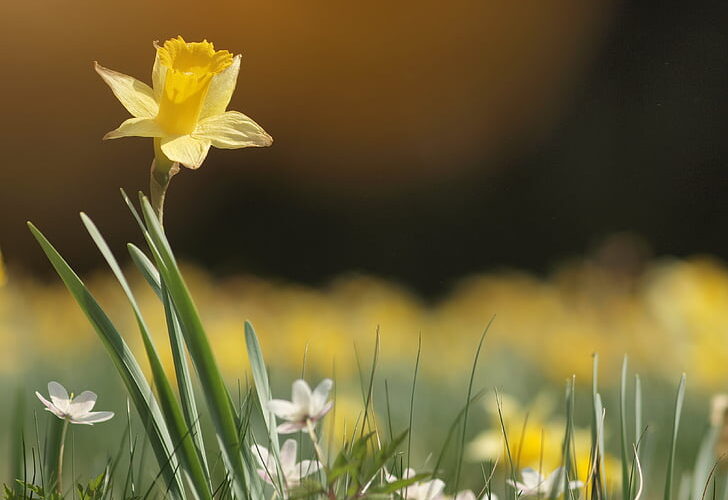Wild daffodils, also known as Narcissus pseudonarcissus, are a charming and iconic spring flower that brightens landscapes with their golden blooms. In this article, we will explore the history, characteristics, cultivation, significance, and ecological importance of wild daffodils. Additionally, we will delve into their symbolism, health benefits, conservation efforts, and their influence in various forms of art and culture.
Table of Contents
What are Wild Daffodils ?
They are perennial flowering plants native to Europe and North Africa. They belong to the Amaryllidaceae family and are characterized by their trumpet-shaped flowers with six petal-like tepals. These delicate flowers vary in color, usually exhibiting shades of yellow and white, and emit a subtle fragrance.
The History of Wild Daffodils
The history can be traced back to ancient civilizations, where they held symbolic and medicinal significance. Their name, Narcissus, is derived from Greek mythology, where a beautiful youth named Narcissus fell in love with his own reflection and transformed into a flower. It have since been cultivated and admired for their beauty and ornamental value.
Characteristics of Wild Daffodils
It display several distinct features, such as their trumpet-shaped flowers, slender green stems, and narrow leaves. These flowers are known for their ability to naturalize and thrive in various habitats, creating stunning displays in woodlands, meadows, and gardens.
Where to Find Wild Daffodils
These are predominantly found in temperate regions of Europe, including the United Kingdom, Spain, and Portugal. They prefer well-drained soils and can be spotted in woodlands, riverbanks, and open fields, offering a delightful sight during the spring season.
How to Grow Wild Daffodils in Your Garden
If you want to enjoy the beauty of wild daffodils in your own garden, you can cultivate them easily. Choose a sunny or semi-shaded spot with well-draining soil and plant the bulbs in the autumn. With proper care and maintenance, they will multiply and reward you with their vibrant blooms year after year.
The Importance of Wild Daffodils in Ecosystems
It play a vital role in supporting ecosystems. Their early bloom provides crucial nectar and pollen for bees and other pollinators, contributing to the pollination of other plant species. Moreover, they serve as a food source for certain wildlife, enhancing biodiversity in their native habitats.
The Symbolism of Wild Daffodils
Throughout history, It have been associated with various symbols and meanings. They symbolize rebirth, renewal, and the arrival of spring, making them popular choices for festive celebrations and new beginnings. In literature and poetry, wild daffodils have often been used as metaphors for beauty, hope, and inspiration.
Health Benefits and Uses of Wild Daffodils
It possess medicinal properties and have been used in springs for treating certain ailments. However, it is essential to note that some parts of the plant contain toxic alkaloids, making them potentially harmful if ingested. Caution should be exercised, and wild daffodils should not be used for self-medication.
Tips for Preserving
As they are a precious natural resource, it is crucial to take steps to preserve and protect them. Avoid picking them from the wild, as this disrupts their natural growth and can threaten their survival. Instead, support conservation efforts and enjoy their beauty in their natural habitats.
Conservation and Protection
Conservation initiatives are vital for safeguarding them and their habitats. Organizations and individuals are working together to ensure the preservation of these delicate flowers, which are not only essential for biodiversity but also contribute to the beauty and ecological balance of natural landscapes.
Popular Varieties
Several varieties exist, each with its unique charm and characteristics. Some of the most popular varieties include the Tenby daffodil, the Lent lily, and the Tengloes daffodil. These distinct varieties add diversity and splendor its populations.
Wildlife and Wild Daffodils
It play a role in supporting wildlife, attracting various insects, birds, and small mammals. Bees, butterflies, and other pollinators are drawn to the flowers, aiding in cross-pollination. In turn, this enhances the overall ecological balance and contributes to the survival of numerous species.
In Art, Literature, and Culture
The beauty and symbolism of wild daffodils have inspired artists, writers, and poets throughout history. They have appeared in numerous paintings, poems, and literary works, depicting themes of beauty, hope, and nature’s wonders.
Conclusion
Wild daffodils, with their enchanting blooms and rich symbolism, are a delightful addition to the natural world. Their significance in ecosystems, art, literature, and culture makes them truly remarkable. As we appreciate their beauty, let us also take responsibility for their preservation, ensuring that future generations can cherish the magic of it.
You can also see: https://bloomblogger.com/education/ielts-preparation/




